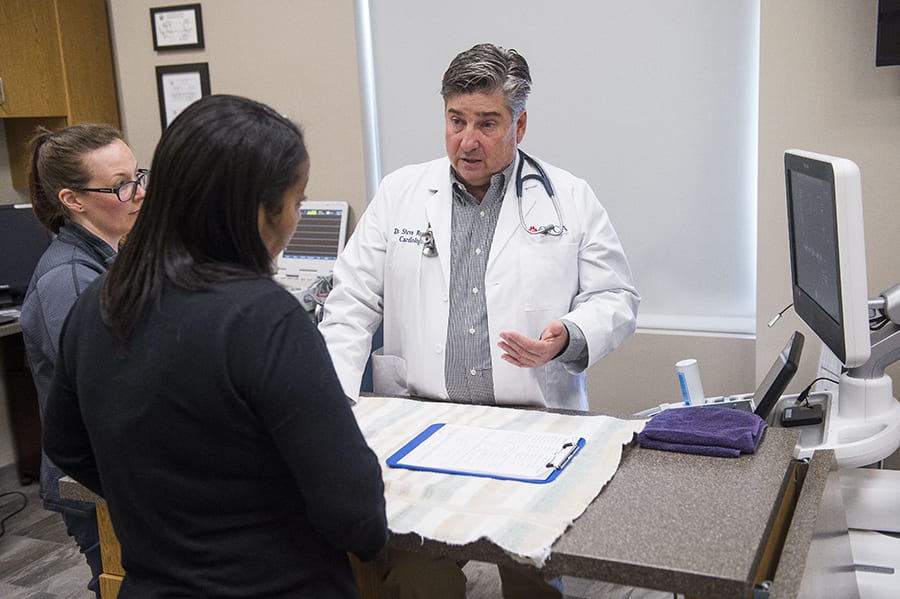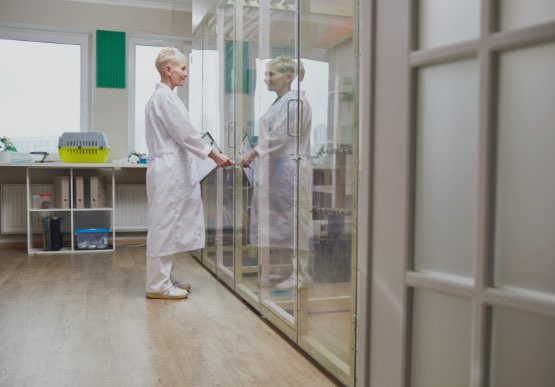The Function of Ultrasound and CT Scan in Modern Veterinary Practices: Insights From Experienced Professionals
In modern-day vet methods, ultrasound and CT scans greatly improve diagnostic capabilities. These imaging techniques offer vital insights into animal health, directing treatment decisions. Experienced specialists identify the one-of-a-kind advantages of each modality. Ultrasound supplies real-time analyses, while CT scans supply complex anatomical information. Recognizing their functions and applications elevates crucial concerns about their effect on individual end results and the future of veterinary diagnostics. What understandings can be gained from their combined usage?
Comprehending Ultrasound in Veterinary Medication
Ultrasound is a necessary diagnostic device in veterinary medicine, providing a non-invasive approach to imagine inner frameworks. This imaging method employs high-frequency audio waves to create real-time photos of tissues and organs, permitting vets to assess conditions without medical intervention. Common applications consist of reviewing the heart, liver, kidneys, and reproductive organs, in addition to checking pregnancies.The procedure is fairly quick and can be done in different setups, making it an accessible option for veterinarians. Unlike radiography, ultrasound gives detailed info regarding soft cells and blood circulation, which is essential for precise diagnoses.Veterinary professionals rely upon ultrasound to detect irregularities such as tumors, cysts, and fluid buildup. Its capability to direct biopsies and other procedures additionally enhances its utility in scientific method. By offering a reliable and secure means to analyze inner anatomy, ultrasound has ended up being a keystone of contemporary vet diagnostics.
The Advantages of CT Checks for Animal Diagnostics
CT checks deal considerable advantages in veterinary diagnostics by supplying improved accuracy in determining inner problems (Board Certified Veterinary Cardiologist). As a non-invasive imaging strategy, they guarantee the security and comfort of pets throughout assessments. In enhancement, CT scans assist in a thorough evaluation of interior frameworks, enabling a lot more effective therapy preparation
Boosted Diagnostic Accuracy
Advancements in imaging innovation have actually considerably enhanced diagnostic accuracy in veterinary medicine, especially through making use of CT scans. These scans provide detailed cross-sectional photos of a pet's inner structures, permitting vets to recognize abnormalities with precision. The high resolution and three-dimensional abilities of CT imaging help with the detection of conditions such as growths, fractures, and inner bleeding that may be missed out on with conventional imaging methods. Furthermore, CT scans can aid in pre-surgical preparation by offering an extensive sight of physiological relationships. This level of detail not only improves the precision of diagnoses however likewise aids in tailoring reliable therapy plans. The assimilation of CT innovation into vet practices is transforming the landscape of animal healthcare, improving results for individuals.
Non-Invasive Imaging Method
The introduction of non-invasive imaging techniques has reinvented animal diagnostics, with CT checks becoming a popular device in veterinary techniques. These scans supply high-resolution, cross-sectional pictures of an animal's internal frameworks, allowing vets to analyze complicated problems without the requirement for intrusive treatments. The benefits of CT scans include their capacity to identify tumors, cracks, and internal blood loss with remarkable precision. In addition, they promote the examination of soft tissues and body organs, enhancing analysis capacities. The rate of CT scanning allows fast decision-making, which is important in emergency situations. By lessening tension and discomfort for the animal, CT scans contribute to an extra humane technique to diagnostics, eventually enhancing therapy outcomes and advancing veterinary care.
Comprehensive Internal Evaluation
A complete internal analysis is necessary for exact medical diagnosis and efficient treatment in veterinary medicine. CT scans offer considerable benefits hereof, supplying detailed cross-sectional pictures of an animal's interior structures. This sophisticated imaging technique boosts visualization of intricate anatomical regions, allowing vets to determine abnormalities such as growths, cracks, and interior bleeding with greater precision. On top of that, CT checks facilitate the analysis of problems that may be challenging to detect with traditional approaches. The rate and accuracy of CT imaging likewise add to prompt interventions, boosting client results. As vet techniques progressively include CT innovation, the advantages of considerable interior evaluations become evident, reinforcing the importance of this device in modern-day veterinary diagnostics.
Contrasting Ultrasound and CT Imaging Techniques
While both ultrasound and CT imaging offer necessary functions in veterinary diagnostics, each method supplies unique advantages and constraints that can influence clinical decision-making. Ultrasound is specifically valued for its real-time imaging capacities, permitting veterinarians to observe dynamic physical procedures. This method is non-invasive, mobile, and does not entail ionizing radiation, making it a safer option for both medical professionals and animals. However, ultrasound might have constraints in picturing certain anatomical structures or deep tissues.Conversely, CT imaging gives detailed cross-sectional views of the body, enabling precise localization of irregularities. It excels in examining facility organs and frameworks, especially in the thorax and abdomen. Nevertheless, CT scans call for sedation or anesthesia oftentimes and entail exposure to ionizing radiation. Ultimately, the selection in between ultrasound and CT relies on the details medical situation, the area of passion, and the seriousness of the diagnostic demands.
Instance Studies: Effective Diagnoses Through Imaging
Case studies illustrate the significant improvements in diagnostic accuracy accomplished via advanced imaging modern technologies like ultrasound and CT scans in veterinary practices. These innovations not only improve the discovery of different problems yet additionally assist in prompt and reliable treatment strategies. Examining details cases can highlight the transformative effect of these imaging techniques on veterinary medicine.
Diagnostic Precision Improvements

Imaging Technology Advancements
As veterinary imaging innovation remains to develop, its influence on analysis abilities comes to be increasingly evident. Current situation researches highlight the successful application of innovative ultrasound and CT scan methods in determining complicated problems. A veterinary facility utilized high-resolution CT scans to identify a rare kind of lung cancer cells in a canine, which traditional imaging had missed. In a similar way, an ultrasound examination revealed a stomach mass in a feline, motivating timely medical treatment and a positive outcome. These advancements not only improve diagnostic precision yet likewise enable veterinarians to create targeted treatment plans. By leveraging advanced imaging innovations, veterinary professionals are significantly enhancing individual care, leading to extra effective navigate to this website management of various health and wellness conditions in pets.
The Role of Imaging in Emergency Vet Care
Imaging plays a necessary role in emergency vet care, providing vets with essential details needed to make rapid, enlightened decisions. In urgent circumstances, methods like ultrasound and CT scans make it possible for experts to quickly analyze a pet dog's internal frameworks, recognizing critical conditions such as internal bleeding, fractures, or body organ irregularities. These imaging modalities enable real-time assessments, promoting prompt interventions that can be life-saving. Ultrasound is invaluable for reviewing soft tissue injuries and conditions like liquid build-up, while CT scans offer comprehensive pictures of complex physiological structures, crucial for diagnosing injury instances. The rate and accuracy of these imaging methods boost the veterinarian's capability to create efficient treatment plans, making certain the very best feasible end results for their clients. The integration of advanced imaging modern technologies right into emergency situation vet techniques is not just valuable however significantly necessary, as it improves diagnostic capabilities and improves general animal care throughout crucial minutes.

Training and Know-how in Veterinary Imaging
Although innovative imaging techniques such as ultrasound and CT scans are vital for reliable veterinary treatment, the successful application of these modern technologies heavily relies on the training and proficiency of vet experts. Efficient use imaging devices requires complete understanding of composition, pathology, and the concepts underlying each method. Vet specialists should undergo customized training to precisely interpret imaging results, which is vital for diagnosing conditions and intending treatment.Certifications and continuing education in veterinary imaging enhance the skills of experts, enabling them to stay upgraded with technological advancements. Partnership in between veterinarians and radiologists commonly leads to improved analysis precision, as experts can give insights right into intricate situations. In enhancement, sensible experience in taking care of imaging equipment promotes self-confidence in its application. Eventually, the top quality of vet imaging services is directly associated to the degree of training and competence had by the specialists utilizing these crucial analysis devices.
Future Fads in Diagnostic Imaging for Animals
With the fast improvements in innovation, vet diagnostic imaging is positioned for substantial evolution in the coming years. Arising trends suggest a change in the direction of more easily accessible and portable imaging techniques, such as portable ultrasound gadgets, which could improve field diagnostics. Additionally, the integration of synthetic knowledge is expected to reinvent picture evaluation, enabling quicker and extra precise analyses of results.Moreover, developments in 3D imaging techniques and computed tomography will give veterinarians with even more comprehensive sights of animal makeup, causing better treatment plans. Online reality innovation may additionally contribute in surgical preparation and education and learning, offering veterinarians a distinct viewpoint on complicated cases.As telemedicine continues to expand, remote appointments promoted by diagnostic imaging will certainly end up being a lot more common, enabling experts to help family doctors in real-time. On the whole, these fads are readied to enhance the performance and performance of vet care, eventually enhancing pet results.
Regularly Asked Questions
Just How Much Do Ultrasound and CT Scans Cost in Vet Facilities?
The expenses of ultrasound and CT scans in vet facilities commonly vary from $300 to $1,500, depending on aspects such as area, facility kind, and particular procedures required for the animal's diagnosis and therapy.

Are There Any Type Of Dangers Related To Ultrasound and CT Scans for Animals?
Ultrasound and CT scans usually present marginal risks to animals. Nevertheless, potential worries consist of sedation reactions and direct exposure to anesthetics. Board Certified Veterinary Cardiologist. Vets very carefully examine each situation to alleviate any threats connected with these analysis treatments
The Length Of Time Do Ultrasound and CT Procedures Normally Take?
Ultrasound procedures navigate to these guys normally take around thirty minutes to an hour, relying on the complexity. CT scans, being more in-depth, normally need thirty minutes to 90 mins, consisting of prep work and recuperation time for the family pet.
Can All Veterinarians Perform Ultrasounds and CT Scans?
Not all vets can carry out ultrasounds and CT scans. Specialized training and accreditation are commonly needed to ensure expertise in these advanced imaging techniques, which may restrict their schedule to veterinarians with additional credentials and sources.
What Kinds Of Animals Profit Most From These Imaging Techniques?
Certain animal types, specifically cats and pets, advantage greatly from ultrasound and CT scans. These imaging strategies improve diagnostic accuracy for problems like growths, inner injuries, and body organ abnormalities, causing improved therapy results and client treatment. The high resolution and three-dimensional capacities of CT imaging assist in the discovery of problems such as tumors, cracks, and inner blood loss that might be missed with conventional imaging approaches. Case research studies highlight the significant renovations in analysis accuracy attained with advanced imaging technologies like ultrasound and CT scans in vet techniques. Improving analysis precision in vet methods has actually been significantly assisted by innovations in imaging technologies such as ultrasound and CT scans. Advanced imaging techniques such as ultrasound and CT scans are crucial for efficient veterinary treatment, the effective execution of these innovations heavily depends on the training and expertise of vet specialists. Vet experts must go through specific training to properly translate imaging results, which is essential for diagnosing conditions and intending treatment.Certifications and proceeding education and learning in veterinary imaging improve the skills of practitioners, allowing them to remain updated with technical innovations.